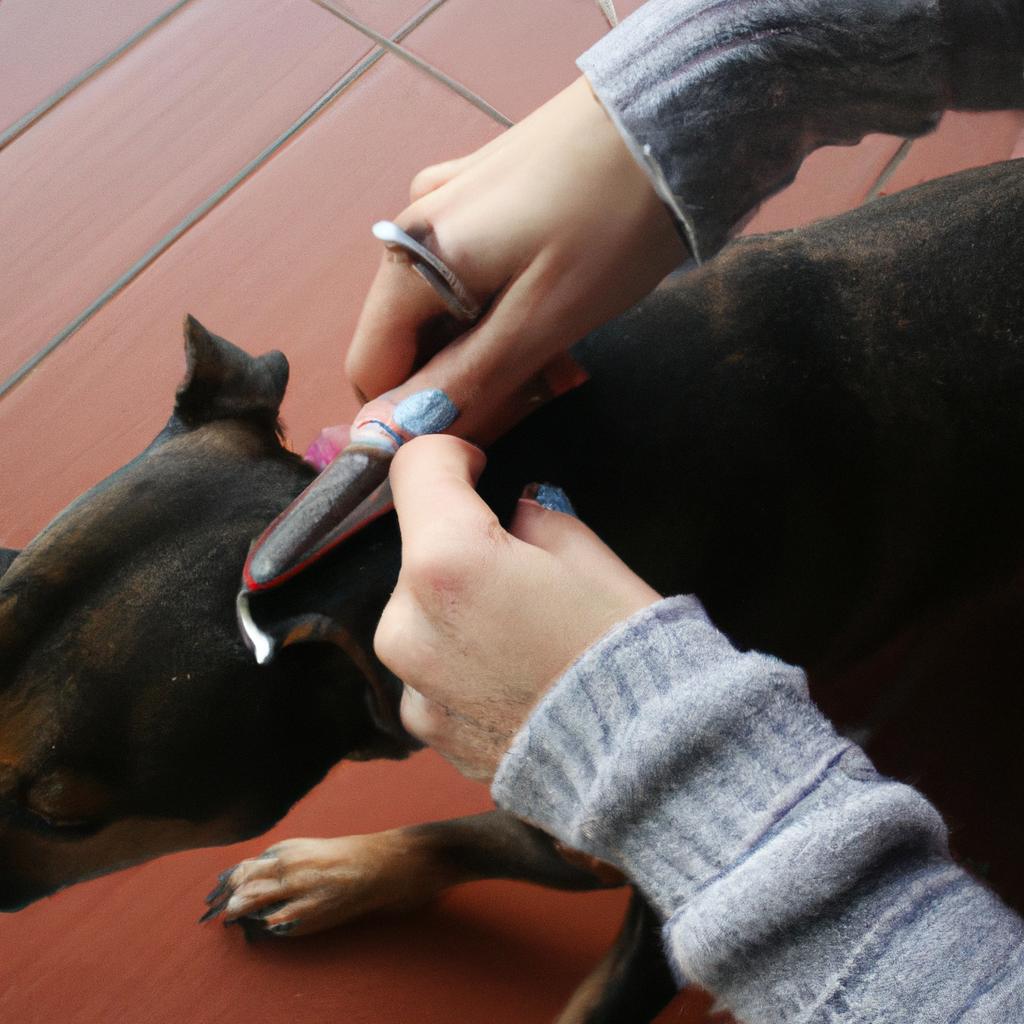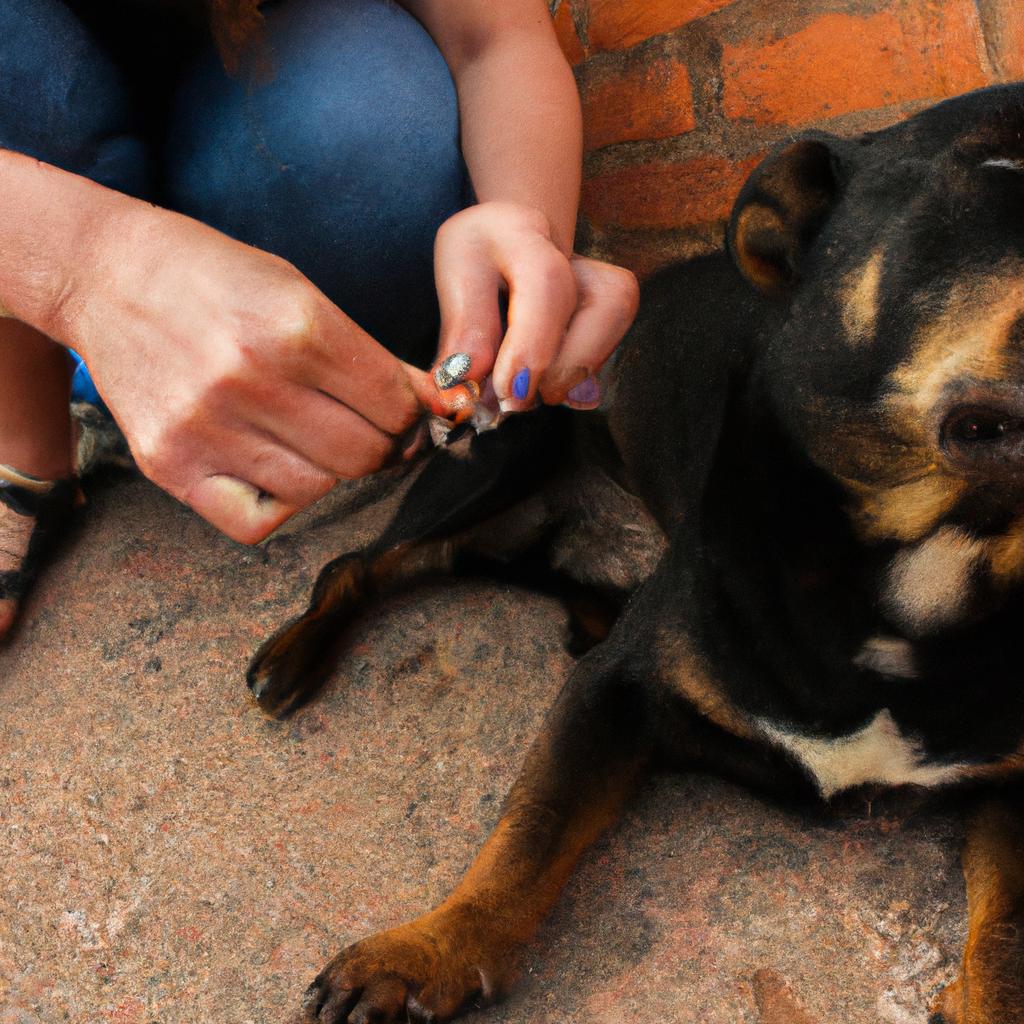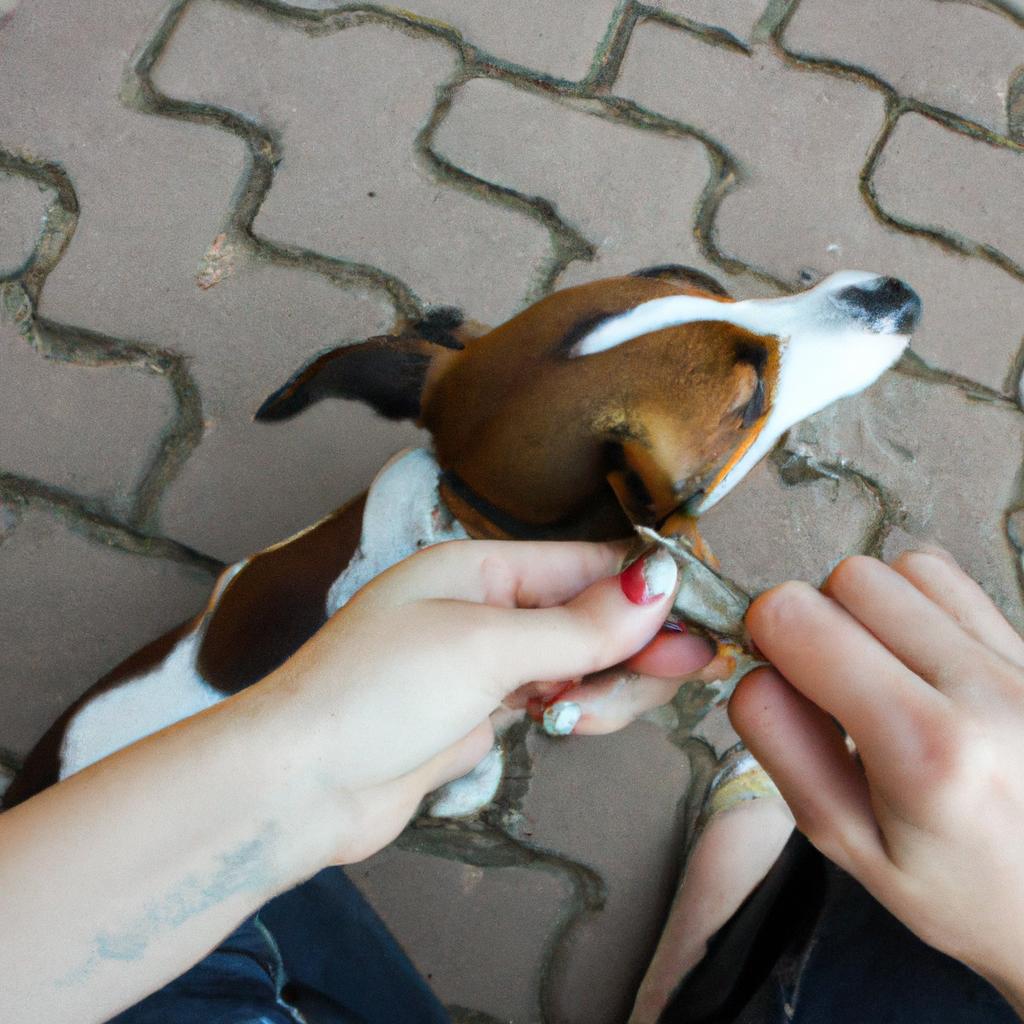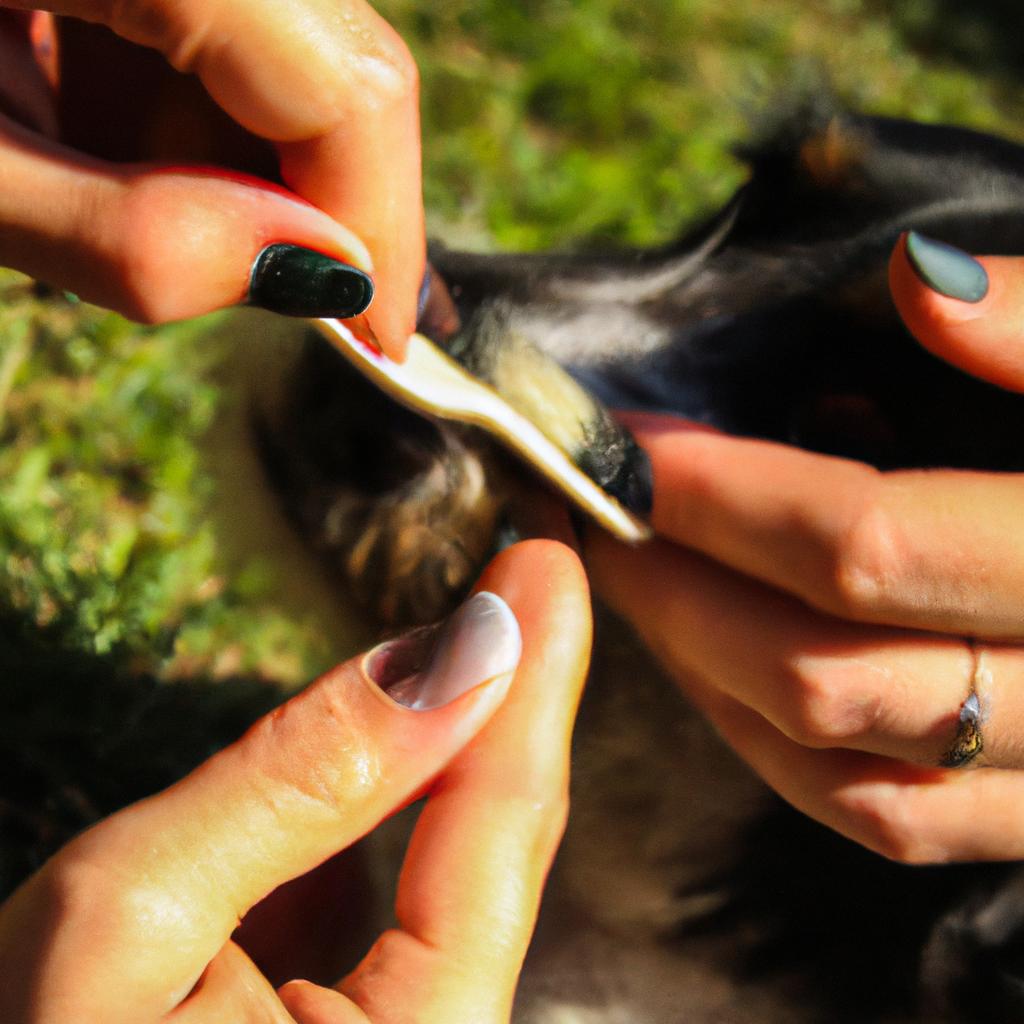Brushing: A Vital Step in Dog Grooming Salon: Nail Trimming

Dog grooming salons play a crucial role in maintaining the overall health and appearance of our canine companions. Among the various services offered, nail trimming stands out as an essential step in ensuring dogs’ comfort and well-being. This article aims to delve into the significance of brushing as a vital preparatory step prior to dog nail trimming at professional grooming salons. By exploring a hypothetical case study that illustrates the benefits of regular brushing, this piece will highlight how proper grooming practices contribute to dogs’ physical and mental welfare.
In our hypothetical scenario, let us consider a medium-sized mixed breed dog named Max. Max’s owner noticed that he had become increasingly reluctant to have his nails trimmed during their visits to the local dog grooming salon. Understanding the importance of addressing this issue promptly, they sought advice from an experienced groomer who emphasized the value of regular brushing sessions before nail trims. Through consistent brushing, Max’s groomer was able to effectively reduce tangles and matting around his paws, reducing discomfort caused by overgrown nails pulling on sensitive skin. This example highlights the direct relationship between brushing and successful nail trimming experiences for dogs like Max, emphasizing its importance within professional grooming settings.
Importance of Brushing in Dog Grooming
Brushing is an essential step in maintaining the overall health and appearance of dogs. It not only helps to keep their coat clean and tangle-free but also plays a crucial role in preventing various skin issues. For instance, consider a hypothetical case study where a dog named Max was neglected when it came to regular brushing. Over time, his fur became matted and started forming tight knots. As a result, poor Max developed hot spots on his skin, leading to discomfort and itching.
To emphasize the significance of brushing, let us explore some key benefits:
- Prevents matting: Regular brushing removes loose hair and prevents it from tangling with existing hair, thereby reducing the chances of mats or knots formation.
- Promotes healthy skin: Brushing stimulates blood circulation under the dog’s skin, promoting healthier skin by distributing natural oils evenly.
- Controls shedding: Frequent brushing helps remove dead hair that would otherwise end up all over your furniture and floors.
- Early detection of potential problems: Through regular grooming sessions, you can observe any abnormalities such as lumps, parasites, or skin irritations early on, allowing for prompt veterinary attention if needed.
The significance of brushing becomes even clearer when considering its impact on different breeds with varying coat types. A well-maintained table below showcases how specific coat types require different levels of care:
| Coat Type | Recommended Frequency |
|---|---|
| Short | Weekly |
| Medium | 2-3 times per week |
| Long | Daily |
By following these guidelines based on coat type, pet owners can ensure they are meeting their furry companions’ individual needs effectively.
Understanding the importance of brushing sets the stage for exploring the subsequent section about “Benefits of Regular Brushing.” By incorporating this vital grooming practice into their routine, pet owners can maintain their dogs’ coats in optimal condition while simultaneously preventing potential skin issues.
Benefits of Regular Brushing
Building upon the importance of brushing in dog grooming, let us now delve into another crucial aspect of maintaining your canine companion’s well-being – nail trimming. By understanding the significance and benefits of this often overlooked procedure, you can ensure that your furry friend remains comfortable and healthy.
Nail trimming is an essential part of regular grooming for dogs. Let’s consider a hypothetical scenario where a dog owner neglects to trim their pet’s nails regularly. Over time, these neglected nails become excessively long, causing discomfort and potential health issues. The dog may experience pain while walking or running due to their nails constantly hitting the ground. Moreover, when left untrimmed, nails can grow into the paw pads, leading to infections and further complications.
To emphasize the necessity of nail trimming in dog grooming salons, here are some key points:
- Preventing injury: Long nails can easily get caught on objects or snagged during playtime or outdoor activities. Trimming them reduces the risk of painful accidents.
- Maintaining proper posture: When a dog’s nails are excessively long, it alters their natural gait and balance, potentially resulting in joint problems over time.
- Promoting foot health: Regular nail trims help prevent ingrown nails and fungal infections that could develop if dirt accumulates under overgrown nails.
- Enhancing overall comfort: Dogs with trimmed nails experience less discomfort when walking or engaging in physical activities.
| Benefits of Nail Trimming |
|---|
| 1 |
| 2 |
| 3 |
| 4 |
In conclusion, nail trimming is a crucial component of dog grooming that should not be overlooked. By maintaining properly trimmed nails, you ensure your furry friend’s comfort and reduce the risk of potential health issues associated with neglecting this essential task.
Now let us move on to the next section about choosing the right brush for effective grooming without causing any unnecessary discomfort or harm to your beloved pet.
Choosing the Right Brush
Imagine a scenario where Max, a lovable Golden Retriever, enters the dog grooming salon. His fur is meticulously brushed and shiny, but his long nails click on the floor with every step he takes. Neglecting nail trimming not only hampers Max’s mobility but also poses potential health risks. In this section, we will explore why nail trimming is an essential aspect of dog grooming.
Regular nail trimming offers several benefits for dogs’ overall well-being:
- Prevents discomfort and pain: Overgrown nails can cause discomfort while walking or running by exerting pressure on the paw pads or altering their posture.
- Reduces the risk of injury: Lengthy nails are prone to breakage or splitting, leading to bleeding and infections that may require veterinary attention.
- Maintains proper foot structure: Trimming nails helps distribute weight evenly on paws, ensuring correct alignment and reducing strain on joints.
- Promotes better traction: Shorter nails provide improved grip on different surfaces, preventing slipping accidents that could result in injuries.
To understand the significance of regular nail maintenance further, let us consider a comparative analysis between two groups – one consisting of dogs who receive routine nail trims and another comprised of those whose owners neglect this crucial grooming procedure.
| Aspect | Dogs Receiving Regular Nail Trims | Dogs with Neglected Nails |
|---|---|---|
| Comfort | Experience increased comfort | May encounter discomfort |
| Mobility | Enjoy unrestricted movement | Hindrance in mobility |
| Health | Reduced likelihood of infections | Prone to infections |
| Long-term Care | Lower risk of joint problems | Increased joint issues |
As evident from the table above, regularly maintaining your dog’s nails through proper trimming ensures enhanced comfort, mobility, and overall health compared to when neglected.
Moving forward, we will delve into the proper techniques for brushing dogs to achieve optimal results. By following these guidelines, you can ensure your furry friend’s coat remains healthy and well-maintained.
[Transition sentence: Now let us explore the next section on ‘Proper Brushing Techniques.’]
Proper Brushing Techniques
Transitioning from the previous section discussing “Choosing the Right Brush,” let us now delve into the proper techniques of brushing your dog’s coat. Understanding and implementing these techniques will not only enhance your grooming skills but also contribute to maintaining a healthy coat for your furry friend.
Imagine you have a Golden Retriever named Max. Max has a thick, double-layered coat that requires regular brushing to prevent matting and keep his fur looking sleek and shiny. By following proper brushing techniques, you can ensure that Max remains comfortable throughout the process while achieving optimal results.
To begin with, it is crucial to establish a calm environment before starting the brushing session. Dogs are highly sensitive creatures who pick up on our emotions; therefore, ensuring a serene atmosphere will help them feel at ease during grooming sessions. Additionally, make sure to use positive reinforcement techniques such as treats or praise, rewarding Max for good behavior during brushing.
When it comes to actually brushing Max’s coat, there are several important steps to follow:
- Start by using a comb or slicker brush to remove any tangles or mats gently.
- Work in small sections and gradually move through the entire body.
- Pay close attention to areas prone to matting like behind the ears, under the legs, and around the tail.
- Finally, finish off with a bristle brush or soft slicker brush to smooth out the hair and give it a polished appearance.
Implementing these techniques regularly will not only maintain your dog’s well-groomed appearance but also provide an opportunity for bonding between you and your pet.
Now let’s take a moment to explore how proper brushing positively impacts both you and your beloved pooch:
| Benefit | Description |
|---|---|
| Improved Health | Regular brushing promotes blood circulation |
| and distributes natural oils throughout their coat | |
| Stress Reduction | Properly brushed dogs experience reduced stress levels |
| and improved overall well-being | |
| Bonding | Brushing sessions create moments of connection |
| and strengthen the bond between you and your dog | |
| Enhanced Aesthetics | Consistent brushing keeps your furry friend’s coat |
| looking clean, shiny, and free from tangles |
Incorporating these techniques into your grooming routine will not only benefit Max but also contribute to his overall health and happiness. By maintaining a diligent approach to brushing, you can prevent common issues such as tangles and mats while ensuring that Max’s coat remains in optimal condition.
Now that we have covered the proper techniques for brushing, let us move on to exploring how to prevent tangles and mats in your dog’s coat.
Preventing Tangles and Mats
Transitioning from the importance of proper brushing techniques, it is crucial to understand how brushing plays a significant role in preventing tangles and mats in your dog’s coat. Picture this scenario: you have neglected regular grooming sessions for your furry companion, resulting in his once lustrous fur becoming matted and tangled. Not only does this affect their appearance, but it also poses potential health risks such as skin irritation, discomfort, and even the formation of painful sores. By following some key preventive measures, you can ensure that your dog’s coat remains healthy and free from these unpleasant issues.
To prevent tangles and mats from forming in your dog’s coat, consider implementing the following strategies:
-
Regular Brushing Schedule:
- Set aside dedicated time each week for brushing your dog’s coat.
- Creating a routine will make both you and your pup comfortable with the process.
-
Appropriate Tools Selection:
- Choose brushes or combs specifically designed for your dog’s breed or coat type.
- Different breeds require different tools to effectively remove loose hair and prevent matting.
-
Gentle Approach:
- Begin brushing gently near the ends of the fur, gradually working your way towards the roots.
- This approach prevents any uncomfortable pulling on tangled areas during the grooming process.
-
Pay Attention to Sensitive Areas:
- Focus on areas prone to matting such as behind ears, underarms, belly, and tail.
- These spots are more susceptible to tangling due to friction or moisture buildup.
By adhering to these preventative measures consistently, you can minimize the occurrence of tangles and mats in your pet’s coat. However, if faced with severe matting or persistent knots despite regular care efforts, seeking professional assistance at a reputable dog grooming salon may be necessary.
In our next section discussing recommended brushing frequency patterns suitable for various breeds, we delve into the ideal intervals between grooming sessions. Understanding these guidelines will further help you maintain your dog’s coat in optimal condition and prevent any discomfort or health issues that may arise from neglecting this essential aspect of their care routine.
Recommended Brushing Frequency
Transitioning from the previous section on preventing tangles and mats, it is crucial to understand the importance of regular brushing in maintaining a well-groomed dog. Neglecting this essential step can lead to various issues such as discomfort for your furry friend and potential health problems down the line. To illustrate its significance, let’s consider an example involving a hypothetical long-haired dog named Max.
Max, a beautiful Golden Retriever with luscious golden locks, belongs to a family who occasionally brushes him but does not adhere to a consistent grooming routine. Over time, Max develops severe matting around his ears and hindquarters. These tight knots pull at his skin, causing pain and irritation. The situation becomes even worse when these neglected areas become breeding grounds for parasites like fleas and ticks.
To prevent scenarios like Max’s case study, here are some key reasons why regular brushing is vital:
- Prevents Tangles: Regular brushing helps remove loose hair and prevents it from tangling with healthy fur.
- Promotes Healthy Skin: Brushing stimulates blood circulation in your dog’s skin, promoting overall skin health.
- Bonding Time: Brushing sessions provide an opportunity for you to bond with your pet while also ensuring their comfort.
- Early Detection: During brushing, you can identify any abnormalities or irregularities such as cuts, bumps, or signs of infection that may require veterinary attention.
In addition to understanding the benefits of brushing, establishing proper frequency is equally important to ensure optimal results and maintain your dog’s coat in peak condition. Referencing guidelines provided by professional groomers and veterinarians will help determine how often you should brush your specific breed based on their unique coat type and length.
By incorporating regular brushing into your dog’s grooming routine, you are taking proactive steps towards keeping them comfortable, healthy, and happy. Remember that each session serves as more than just maintenance; it allows you precious moments together while ensuring your four-legged companion looks and feels their best.





